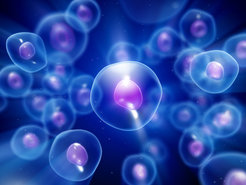Water is simply water – even in living cells
A team of scientists from Mainz and Amsterdam shows that living cells cannot alter the properties of water over longer distances
Living cells consist primarily of water and the inside of cells constitutes a very crowded environment, with a variety of biomolecules, including DNA, sugars, proteins, salts, etc. While it has been anticipated that these biomolecules affect the properties of water, the question how exactly the water is affected is still discussed controversially. It is for instance often speculated that biomolecules not only affect water in their direct vicinity, but can affect water structure over distances of up to a few hundreds of water layers. Besides solid water (ice), liquid water, and water vapor, water in cells – so-called biological water - is sometimes even considered to constitute the fourth state of water.
A team of scientists from the Max Planck Institute for Polymer Research and the University of Amsterdam has now directly studied the properties of water in living cells. Therefore the scientists have specifically studied the rotation of water molecules, which is very sensitive to local structural changes. From these experiments, it became apparent that in all studied cells most water molecules behave just as regular water and only a minor fraction of water molecules moves slower.
Laser pulses and microwaves to detect water rotation

Using short laser pulses and high-frequency microwaves the researchers had a closer look at the rotational motion of water molecules. Microwaves can make water molecules rotate (similar to what happens in a microwave oven) and thus rotation of the water molecules is studied via the absorption of the microwaves. Complementary to the microwave experiments, water molecules that happen to point into a specific direction can be labeled via excitation of water’s vibrations with polarized infrared laser pulses. The rotation of water is then monitored in real-time by determining the change in orientation of these vibrating water molecules.
Investigation of different cells
In their study the researchers have investigated water in three different organisms: yeast cells, E.coli bacteria, and spores of grass bacillus. The experiments showed that in cells the largest fraction of water molecules rotates just as water molecules in liquid (tap-) water. Only a minor fraction of water in cells, namely those water molecules in direct contact with biomolecules, moves slower. This even holds true for the relatively dry spores, which can survive extremely harsh conditions like long-lasting droughts. The results, published in Nature Communications, show that water in living organisms behaves just like normal water and there is no justification for evoking biological water as the fourth state of water: also in living cells, water is simply water.












